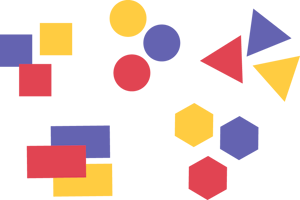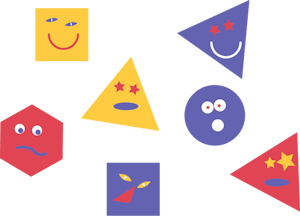D1.1 Sort sets of data about people or things according to one attribute, and describe rules used for sorting.
Skill: Sorting and Classifying Sets of Data
Sorting involves grouping objects that have a common characteristic (for example, objects that are large) and discarding those that do not (for example, objects that are not large).
Classifying involves the identification of a common attribute among all items within a group (for example, size). Items are then categorized according to different characteristics of that attribute (for example, large, medium, small).
Sorting and classifying skills include the ability to:
- determine classes from at least one attribute;
- group objects appropriately in these classes.
To sort and classify objects, based on their observation of these objects, students must first be able to choose those that have a common characteristic and discard those that do not. They can also sort the discarded objects in order to distribute them in other classes. It is important that students have the opportunity to sort and classify the same objects in a variety of ways. By using and, or, and not appropriately, students expand their classification schemes. (Van de Walle and Lovin, 2007, p. 336) An activity that requires defining classes using the link word or (for example, triangles or squares) is a complex activity. These two skills develop almost simultaneously. The close connection between sorting and classifying often makes these two skills difficult to observe separately. To facilitate this observation, teachers should choose contextualized problems, making more use of either sorting or classifying.
Source: translated from Guide d’enseignement efficace des mathématiques, de la maternelle à la 3e année, Traitement des données et probabilité, p. 36-37.
Knowledge: Attribute
An attribute of an object corresponds to one of its observable properties (for example, colour, shape, size).
The concept of attribute is very important as it is found and used in all areas of mathematics. When it comes to sorting and classifying, the attribute of an object becomes the criterion for classification and the characteristics of the attribute define the classes or categories. In order to classify, students must:
- observe several attributes of the object (for example colour, material, size);
- choose an attribute for the classification;
- determine some characteristics of this attribute (for example, if the attribute is material, the characteristics can be wood, plastic, paper).
Determining the characteristics of an attribute is usually easier than defining the attribute itself, because defining an attribute requires synthesis. For example, if students observe that buttons are smooth, rough, or wavy, they will use these characteristics to define the three classes into which the buttons will be grouped. After analysis, students will be able to recognize the three characteristics of the texture attribute. In some cases, it may be best for teachers to suggest the choice of an attribute at the beginning.
Note: Attributes are used to sort and categorize data, and categories are used to create tables and graphs.
Through the activities, students become aware that the description of a set must be accurate so that it can be determined with certainty whether or not an object belongs in the category. For example, they realize that categories such as “fat, not fat” or “funny, not funny” are subjective and can vary depending upon the person making the classification.
Some object descriptions are based on comparison. When the attribute corresponds to a measurement (for example length), the characteristics can be defined using a comparison (for example objects longer than chalk).
Students need to understand that every object has many attributes. To facilitate this understanding, teachers should provide students with a variety of activities in which they try to describe objects, focusing on observing and analyzing the similarities and differences between objects. Teachers can then record the descriptive elements and model a way to organize this information in a table. The following is an example of a table.
Classification of Buttons
| Attributes | Characteristics |
|---|---|
| material | plastic, metal |
| size | small, big |
| shape | round, square |
Examples of classroom materials
- Attribute blocks
Each piece has a limited number of attributes (shape, size, thickness and colour). These characteristics are as easy to recognize as they are to describe. For example, the characteristics corresponding to the shape attribute are: square, round, rectangular, triangular, and hexagonal.

- Pattern blocks
Pattern blocks have different attributes whose characteristics allow different classifications (for example, according to colours, according to the name of the figure, according to the number of sides).

- Homemade and found materials
Homemade materials, in other words, materials created from scratch, have the advantage of presenting precisely the attributes and characteristics that you wish to emphasize. As an example, each piece below has attributes (for example, eye shape, colour, symmetry, number of sides, number of vertices) and characteristics (for example, circle, star, diamond, oval eyes) that are easy to recognize and describe.
 Image Five geometric mosaics of different shapes and colors, displaying various expressions, a yellow square with a red line forming a smile and blue eyes in the shape of diamonds; a yellow triangle with a blue oval-shaped mouth and red star-shaped eyes; a red hexagon with a blue sinuous line for the mouth and two white and blue discs for the eyes; a blue square with a red triangle for the nose and yellow lozenge-shaped eyes; a blue triangle with a white line forming a smile and red star-shaped eyes; a blue disc with a white mouth in the shape of a disc and white and red discs for the eyes; a red triangle with a blue oval mouth and yellow stars for eyes.
Image Five geometric mosaics of different shapes and colors, displaying various expressions, a yellow square with a red line forming a smile and blue eyes in the shape of diamonds; a yellow triangle with a blue oval-shaped mouth and red star-shaped eyes; a red hexagon with a blue sinuous line for the mouth and two white and blue discs for the eyes; a blue square with a red triangle for the nose and yellow lozenge-shaped eyes; a blue triangle with a white line forming a smile and red star-shaped eyes; a blue disc with a white mouth in the shape of a disc and white and red discs for the eyes; a red triangle with a blue oval mouth and yellow stars for eyes.
Look-Fors During an Attribute Search Activity
Observe if students:
- explain the differences between the objects;
- note the details;
- compare the characteristics;
- create sets;
- compare objects that are not in a category to determine the characteristics of the category;
- define the attribute.
Suggestions for Preparing a Collection of Different Objects
- Select approximately 20 objects that display several attributes and characteristics. Ensure that a common characteristic is represented by more than four of these objects.
- Choose objects that allow for some creativity in the choice of attributes and characteristics (for example, brittle: breakable, unbreakable; country of manufacture: France, Canada).
- Refrain from using objects that are predominantly colourful to avoid having students focus solely on that attribute.
- Prepare several identical collections and place the objects in plastic freezer bags.
- Retain additional items to replace those items that are lost or broken.
Source: translated from Guide d’enseignement efficace des mathématiques, de la maternelle à la 3e année, Traitement des données et probabilité, p. 38-42.
Ideas for Classroom Interventions
To encourage students' thinking when sorting and classifying, (for example, plane shapes), ask questions such as:
- Why is this circle in this category and not in the other?
- How is this square similar to other shapes in the same category?
- What shape doesn't fall into this category? Why?
- How does the square differ from the oval?
To encourage them to classify the same plane shapes by another attribute, ask questions such as:
- Can we group these shapes in another way?
- If I remove these shapes, how would we classify the remaining ones? Why?
- If these two shapes were placed in the same category, what would we name this new category?
Source: translated from Guide d’enseignement efficace des mathématiques, de la maternelle à la 3e année, Traitement des données et probabilité, p. 45.
Knowledge: Characteristic
An attribute characteristic describes how the attribute is reflected in a particular object (for example, if the attribute is colour, the characteristics might be red, blue, yellow).
The table below shows some examples of attributes and characteristics that students could use to classify a collection of buttons.
| Attributes | Characteristics |
|---|---|
| texture | smooth, rough or wavy |
| number of holes | 0, 2, 3 or 4 |
| size | small or big, long or short |
| thickness | thin or thick |
| shape | round or not round |
| colour | red, blue, or black; brown or not brown |
Source: translated from Guide d’enseignement efficace des mathématiques, de la maternelle à la 3e année, Traitement des données et probabilité, p. 38-39.
